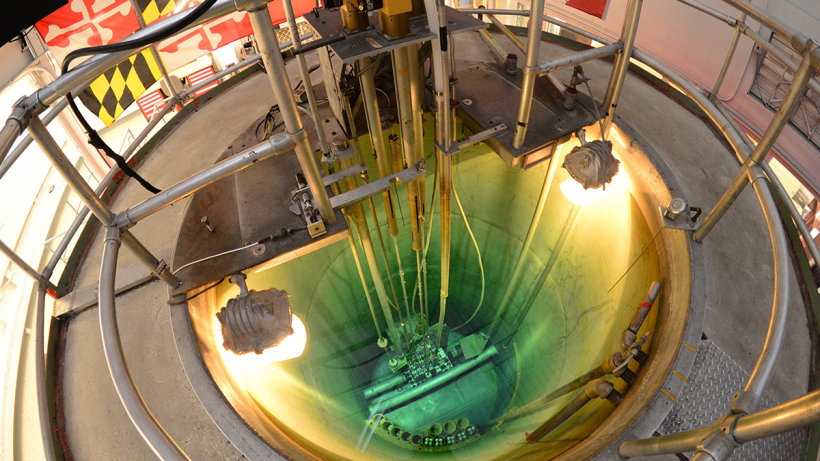In this illustration of the effects of two neutron yields (50 kt and 1 Mt) and two neutron energies (14.1 MeV and 1 MeV), the black dots represent the location of a nuclear device. Dark blue indicates where the asteroid remains solid, while all other colors show where material has been melted or vaporized. The illustration depicts asteroids with 0.8-m and 5-m diameters—much smaller than the 300-m asteroid simulated in the study—to enhance the visibility of the area of the energy deposition. Image: LLNL
A research collaboration between Lawrence Livermore National Laboratory and the Air Force Institute of Technology (AFIT) has investigated how the neutron energy generated by the detonation of a nuclear device could affect the path and speed of an asteroid on a collision course with Earth by melting and vaporizing a portion of the asteroid. The research, which compared the deflection caused by two different neutron energies—14.1 MeV and 1 MeV, representing fusion and fission neutrons, respectively—is described in an article published by LLNL on April 8.
Crews move equipment used to inspect drums holding diluted plutonium into a storage site in K Area at the Savannah River Site. Photo: DOE
Workers at the Department of Energy’s Savannah River Site in South Carolina recently finished transferring equipment to the site’s K Area in preparation of shipping downblended plutonium to the Waste Isolation Pilot Plant in New Mexico for disposal. The plutonium is part of the 34 metric tons of surplus plutonium the National Nuclear Security Administration plans to ship to WIPP under the “dilute and dispose” option the department adopted following the cancellation of the MOX Fuel Fabrication Facility project.
NCSU: Site of the 2021 ANS Student Conference
North Carolina State University was finally able to host the ANS Student Conference, April 8 to 10. After the 2020 event was canceled due to the global coronavirus pandemic, the 2021 version is being held virtually for the first time.
The conference's opening session is available for registered attendees to view online.
Florida’s Turkey Point nuclear plant. Photo: FPL
The Nuclear Regulatory Commission on April 6 issued a violation notice and proposed a $150,000 civil penalty to Florida Power & Light Company for falsifying plant records and recording inaccurate data in maintenance records at its Turkey Point nuclear power plant near Homestead, Fla.
Point Beach Units 1 and 2. Photo: NRC
An atomic safety and licensing board has been established to address a hearing request filed on behalf of an antinuclear group regarding the subsequent license renewal (SLR) application for NextEra Energy’s Point Beach reactors, located near Two Rivers, Wis. The Nuclear Regulatory Commission published notice of the panel’s formation in the April 2 Federal Register.
The Maryland University Training Reactor, one of 12 TRIGA reactors currently operating at universities in the United States. Photo: University of Maryland
TRIGA International, the only supplier of TRIGA reactor fuel in the world, recently completed a major renovation project at its fuel fabrication facility in Romans, France. The Department of Energy, which provided both technical and financial support for the project, said the upgrades ensure the continued operation of 36 TRIGA reactors around the world, including 18 in the United States.
Workers remove asbestos siding panels from a Portsmouth Gaseous Diffusion Plant building. Photo: Business Wire
Fluor-BWXT Portsmouth, a joint venture of Fluor and BWX Technologies, along with engineering company Jacob, have received a contract extension valued at up to $690 million, including options, from the Department of Energy. The contract, announced April 6, is for environmental management work at the former Portsmouth Gaseous Diffusion Plant near Piketon, Ohio.
Byron Generating Station. Photo: Exelon
The University of Illinois Student Section and Chicago Local Section of the American Nuclear Society hosted a webinar, The Role of Nuclear Power in Illinois, on Wednesday, March 31. The webinar provided information for state lawmakers and the general public about the potential consequences of closing the Byron and Dresden Generating Stations, two of the nuclear power plants in the state of Illinois.
The webinar recording has been archived and is available for viewing for free at the above link.
Dry cask storage at the closed San Onofre Nuclear Generating Station in Southern California. Photo: Southern California Edison
Saying they are cautiously optimistic that the Biden administration can change the U.S. trajectory on nuclear waste, some Stanford University experts have offered their recommendations on how it can be done in a recent Stanford news posting.
A prototype neutrino detector deployed outside Unit 2 at Dominion Power’s North Anna Generating Station in Mineral, Va. Photo: Steve Mackay, Virginia Tech
Barakah-1 (right) is now providing reliable and sustainable electricity around the clock. Photo: ENEC
Unit 1 at the United Arab Emirates’ Barakah nuclear power plant has entered commercial operation and is now providing “constant, reliable, and sustainable electricity around the clock,” the Emirates Nuclear Energy Corporation (ENEC) announced this morning. ENEC added that, as a result of the event, the company now leads the largest decarbonization effort of any industry in the UAE.
The outside of the DIII-D tokamak, where testing that supports the development of the Compact Advanced Tokamak has been performed. Photo: General Atomics
Scientists at the DIII-D National Fusion Facility have published research on a compact fusion reactor design they say could be used to develop a pilot-scale fusion power plant. According to General Atomics (GA), which operates DIII-D as a national user facility for the Department of Energy’s Office of Science, the Compact Advanced Tokamak (CAT) concept uses a self-sustaining configuration that can hold energy more efficiently than in typical pulsed configurations, allowing the plant to be built at a reduced scale and cost.
An artist’s rendering of Natrium. Image: TerraPower
Around the world, national and local policymakers and business leaders are making bold and ambitious commitments to clean energy goals. In the United States, one in three Americans now lives in a city or state that has committed to or has achieved 100 percent clean electricity, according to the Luskin Center for Innovation at the University of California–Los Angeles.
Photos of physicist Alessandro Bortolon and the element boron; graph and photo showing the interior of a tokamak. Credit: Alexander Nagy and Alessandro Bortolon/Collage courtesy of Elle Starkman, PPPL
Research led by scientists at the Department of Energy's Princeton Plasma Physics Laboratory (PPPL) provides new evidence that particles of boron, the main ingredient in Borax household cleaner, can coat internal components of doughnut-shaped plasma devices known as tokamaks and improve the efficiency of the fusion reactions, according to an article published on Phys.org on April 2.









 New research indicates
New research indicates









